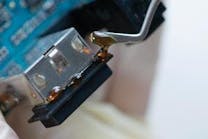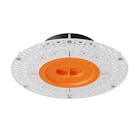Date Announced: 16 May 2011 Surface Mount Techniques (SMT) has introduced several thermal grease printing machines that accommodate larger, odd shaped substrates such as the heat sinks found in LED lighting. The picture shows two different heat sinks with thermal grease applied using SMT’s automatic printers. The picture illustrates the use of a .004-inch thick screen (left), a 0.006-inch stencil (right).When discussing LED lighting, highly concentrated heat sources come with the territory. The latest LED lighting designs require much better heat dissipation. Heat sink designs are highly integrated and much more complex. Thermal Interface Material (TIM) suppliers have met industry demands with higher performance thermally conductive materials. Among various TIM offerings, thermal grease can provide the lowest thermal resistance at the junction between the heat source and heat sink. However, this junction can still be the weak link in a thermal path. If the grease is not applied properly heat is trapped at the source and failures occur. When applied properly a good thermally conductive path is created for better heat dissipation. The thermal grease may be applied to the substrate of the heat-source or the substrate of the heat sink. When applying thermal grease to the substrate, heat sink designers want better process control. Manufacturers want the same, as well as higher production rates. What’s needed is the accuracy and repeatability of automated stencil printers such as those used to apply solder paste on Printed Circuit Boards (PCB). These stencil/screen print machines control the squeegee speed and pressure to apply a consistent thickness of paste (grease) in precise locations. Although printing thermal grease is similar to printing solder paste, applying grease to a densely populated LED board or the heat sink itself presents certain challenges. Bare PCBs are lightweight and usually .062-inches thick compared to heat sinks that are large (up to 5.0 inches thick), bulky and heavy. The heat sink may not have a single plane and/or it may have obstructions protruding above the print surface where grease needs to be applied.SMT has introduced several thermal grease printing machines that accommodate larger, odd shaped substrates such as the heat sinks found in LED lighting The machines offer the same speed, precision, and repeatability found on SMT’s solder paste printers. The 1616TC and 1616TCS printers are tabletop machines used for R&D or production. The 1616TC is a standard clamshell style printer. For heat sinks that are too cumbersome to handle the 1616TCS includes a shuttle mechanism to extend the tooling plate from under the screen/stencil. This allows simpler loading/unloading of the heat sink.Engineers use the 1616TC for printing on prototype heat sinks. Application of the grease is held constant to insure test data is not contaminated by inconsistencies resulting from manual operations. When the correct process is determined by engineering the proper machine parameters are easily transferred to production. The 2220TC is a production machine with many options available such as automatic vision alignment and post-print vision inspection. The 2220TC has a large work area accessible from three sides of the machine for additional pre or post-print automation including custom handling (load/unload) and custom assembly (pick & place robotics). SMT also provides engineering assistance as required for custom tooling to register and secure odd shaped substrates during the print process. In conclusion, LED Lighting manufacturers benefit from using proven, cost effective stencil/screen print technology. They realize better control of their process and higher production rates.
Contact
Patrick Sean Surface Mount Techniques SMT 15632 Producer Lane Huntington Beach, CA 92649 (714) 903-8100 ext. 21
E-mail:[email protected]
Web Site:www.smtprinters.com






